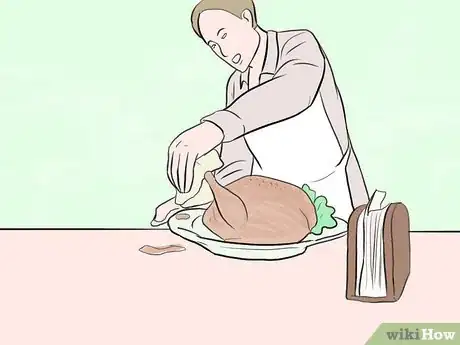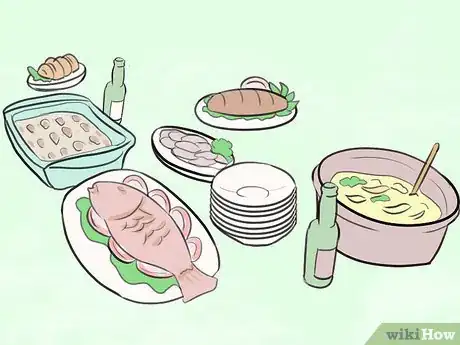X
wikiHow is a “wiki,” similar to Wikipedia, which means that many of our articles are co-written by multiple authors. To create this article, 14 people, some anonymous, worked to edit and improve it over time.
This article has been viewed 57,164 times.
Learn more...
Are you a foodie? Do you love to cook? Do you love gathering with friends over a great meal, but don’t want to do all the work yourself? Consider starting a “cooking club” where you cook and eat together. It's a great way to deepen your friendships while enjoying terrific food.
Steps
Method 1
Method 1 of 3:
Starting Out
-
1Consider whether this is for you. If you love to talk and think all things food, find your bliss when shopping food and end up more often than not at the farmers market to do your food shopping, then you're the perfect candidate to start a cooking club.
- If you love talking about food with others, and enjoy all the nuances and specifics about special food products, a cooking club will provide you with the outlet to share this love with people who have the exact same passion. No more need to talk endlessly about the intricacies of food to a bewildered spouse or family member; use the club to get this out of your system!
- If your cookbook collection has its very own bookshelf and is bulging at the seams, it's time to get the books down and start cooking those recipes with fellow foodies!
- Ask yourself what you want to get out of the club. Do you want to save money, make new friends, discover new cuisines, share recipes, etc.? You may have various motivators, and it's important to recognize these up front, so that you can begin tailoring the club toward this end and attract like-minded members.
-
2Find fellow foodies. A group of people who enjoy cooking is essential to creating a vibrant club. These people don’t have to be close pals of yours, or even of each other, when the club starts. Rather, they have to be willing to pitch in and share in the cooking, and be the type that would actually enjoy that. Five or six people is a good size, especially if you’re all trying to cook in one kitchen.
- Advertise online for possible foodie club members. Use Facebook, Twitter, MeetUp and other resources to find people.
- Leave small advertisements on community bulletin boards, inviting people to come along to a first meeting.
- Ask foodie friends along and ask them to see if they know of anyone who might like to come along as well.
- When seeking members, think carefully about the criteria. You might want people with families, single people, people with a busy lifestyle, etc.––whatever matches your own needs is a good place to begin. Specify the parameters as part of your advertising.
Advertisement -
3Decide where to hold the first club meeting. You may wish to have the first meeting at your house, if you feel it's safe enough to do so. It's always advisable to have other people you know and trust around when you first meet the new club members. If you're not sure about bringing them into your home to begin with, hold the first meeting at a local cafe, bar or restaurant–-anywhere you can share and critique food together. After the club is established, the idea is to use your home kitchens and dining areas, once the trust is in place.
- At the first meeting, discuss meeting dates. Use an online calendar with reminder notices to help keep track of the cooking club dates.
- Try to aim for a regular monthly date. It's important to realize that not all members will manage to make every meeting––build that reality into the flexibility of your meetups.
Advertisement
Method 2
Method 2 of 3:
Allocating Responsibilities
-
1Decide how to run the cooking sessions. There are lots of possible ways to run the "cooking" part of a cooking club, and it's something that you'll need to discuss together and reach a consensus on. Nothing is set in stone and no exact way is right over any other. Some suggestions include:
- Theme cooking: Choose a theme that you are all interested in learning more about, such as national country-specific cooking (French, Greek, Chinese, etc.); party cooking; baking; candy-making, etc.
- Try-something-new cooking: Have club members come with a dish from a cuisine they've never attempted before.
- Cooking together: Instead of bringing a dish, bring a recipe and have everyone pitch in together to make the recipes for a whole meal.
- Freezer-friendly cook-up: You get to cook one meal in enough quantities for, say 4 club members, share this meal with the others and keep their additional meals to place in your freezer for the upcoming month! For those who like the idea of freeze-ahead meals but lack the motivation, a club can help get you right into this time-saving measure.
- Budget cooking: A cooking club can be a fantastic way to pool resources to pay for more expensive food items.
- Making preserves: Preserves (jams, jellies, chutneys, vinegar- and oil-preserved food, etc.) are wonderful to have in the pantry but finding the motivation and adequate knowledge to make them alone can feel daunting. As part of a club, you can share lots of ideas, have many helping hands and each of you take home a jar or more after each club session!
- Deconstructed store food: For those lacking in time, hold sessions where you're perfectly allowed to build on bought food and try to improve on it, rather than cooking from scratch. Even if this isn't your usual theme, this can be a good one for busier times (such as holiday season) or when lots of members are away (summer vacation time).
- Parents/carers and kids cook-up: Teach your kids how to cook in a group situation––this can be great for sharing ideas around and keeping your patience intact while the mess gets cleaned up by everyone involved!
- Book club-meets-cooking club: An occasional read of a book about food––chef's, restaurateur's and foodie travelers' experiences, etc. all qualify for good food reads; some cookbooks might be okay if they contain enough interest beyond a mere assembly of recipes. Have a chat about how you found the book, then head off to cook something inspired by the reading!
-
2Take turns. While you’ll need to have one person who organizes things a bit, the fun of a cooking club is sharing the labor. The location for meetings rotates as group members take turns hosting the monthly dinners.
- One possible approach: The host makes the main course, others bring appetizers, side dishes, desserts, and so on.
- Another approach: The host decides on the month's theme and allocates recipes or rosters specific members onto different aspects of the meal if cooking it together.
- A random approach: Don't ask, just turn up with a dish. If this means everyone turns up with snacks or dessert, that's dinner for the night!
- A cleaning roster is probably helpful too––don't make it so that the host is left with all the cleaning up afterward! You might like to consider eco-friendly disposable plates and utensils, to lessen the cleaning burden.
Advertisement
Method 3
Method 3 of 3:
Keeping Intact the Spirit of Sharing and Learning Together
-
1Focus on friendship. A cooking club offers its members hospitality in its truest form. Our culture often misunderstands hospitality as entertaining in high style. But true hospitality is not about impressing people, or creating the perfect experience or the fanciest dishes around a Pinterest-worthy table. Rather, it’s about being authentically welcoming, making others feel comfortable.
- Treat hospitality as your chance to express your love and warmth for others through sharing food, time and attention to each other. It isn't about who can do the better job at entertaining.
- Be welcoming and gracious when hosting others in your home. Be willing to try new things and to share ideas together, so that you all make interesting discoveries about the art of cooking.
- Enjoy the company of your friends as much as the food.
-
2Embrace imperfection. This is not a place to compete or try to outdo one another. The group members should understand that the cooking club is a place of giving each other the space to learn and to share. As Niequist notes, "[i]t’s about declaring your table a safe zone, a place of warmth and nourishment."
- Encourage the club members to experiment and be supportive when their endeavors don't work out as they'd hope. Use the lessons you all learn together to improve your cooking skills and techniques.
-
3Keep the memories and even share beyond your group. Take plenty of photos of the food you cook and the fun you are having together. Consider compiling an eBook of the recipes you make together and sending this around to each other. And if you like, share the photos (and recipes/tips) online with other friends and followers, on sites such as Facebook, Twitter and Google+. Readers will enjoy seeing the smiles and joy of club members, as well as learning something from your experiences.
- Consider running your own blog for the cooking club. Either a passionate enthusiast of blogging could take on this role, or all of you could offer to do a write-up in rotation. The blog could report on club events, recipes tried, cookbooks reviewed, club members' wisdom, etc.
- Pinterest, Indulgy and the like are good to use but avoid creating dishes and images for the sake of uploading. Use these sites as your club's tool to show what happened organically and without obligation, not as the mandatory directive for what your club should achieve.
Advertisement
Warnings
- Be careful not to turn away members for fear your home isn't big enough. It'll be the rare occasion that every single club member of a large group can make the regular meetup, so having lots of members can ensure that it always works. If you do end up with a crowded house, find ways to spill outside or into other parts of the house.⧼thumbs_response⧽
Advertisement
Things You'll Need
- Recipes
- Cooking gear
- Food ingredients
- Take-home and leftover containers/bags/food wrap
About This Article
Advertisement


































































